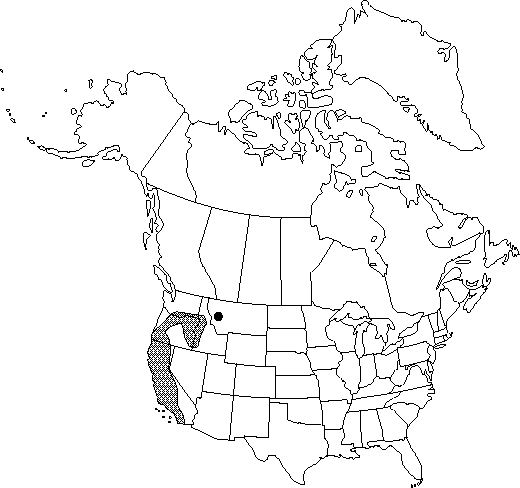Alnus rhombifolia
N. Amer. Sylv. 1: 49. 1842.
Trees, to 35 m; trunks often several, crowns spreading, open. Bark light gray, smooth, becoming darker and breaking into scales in age; lenticels inconspicuous. Winter buds stipitate, ellipsoid to obovoid, 3–9 mm, apex rounded; stalks 3–5 mm; scales 2, equal, valvate, sometimes incompletely covering underlying leaves, moderately to heavily resin-coated. Leaf-blade narrowly elliptic to rhombic, rarely ovate, 4–9 × 2–5 cm, base cuneate to rounded, margins flat, finely serrate or serrulate, sometimes slightly lobed, without noticeably larger secondary teeth, apex acute or obtuse to rounded; surfaces abaxially sparsely pubescent to villous. Inflorescences formed season before flowering and exposed during winter; staminate catkins in 1 or more clusters of 3–7, 3–10 cm, stamens 2, or 4 with 2 reduced in size; pistillate catkins in 1 or more clusters of 2–6. Flowering before new growth in spring. Infructescences ovoid to nearly cylindric, 1–2.2 × 0.7–1 cm; peduncles 1–10 mm. Samaras broadly elliptic, wings narrower than body, irregular in shape, leathery.
Phenology: Flowering early spring.
Habitat: Open, rocky stream banks and adjacent (often rather dry) slopes
Elevation: 100–2400 m
Distribution

Calif., Idaho, Mont., Oreg., Wash.
Discussion
Alnus rhombifolia is the common alder throughout the dry Mediterranean climatic zone of coastal western United States. Mexican populations are not known, but because A. rhombifolia has been collected as far south as San Diego, California, it should be expected in adjacent Baja California.
Native Americans used various parts of Alnus rhombifolia medicinally for diarrhea, consumption, and burns, as a blood purifier, an emetic, and a wash for babies with skin diseases, and to facilitate childbirth (D. E. Moerman 1986).
Selected References
None.